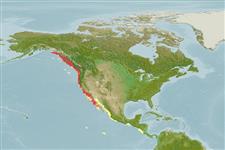分类 / Names
俗名 | 同种异名 | Catalog of Fishes(属, 种) | ITIS | CoL | WoRMS | Cloffa
Holocephali
全头亚纲 (银鲛科) (chimaeras) >
Chimaeriformes (Chimaeras) >
Chimaeridae (Shortnose chimaeras or ratfishes)
Etymology: Hydrolagus: hydro-, combining form of hydor (Gr.), water; lagos (Gr.), hare, i.e., “water rabbit,” probably referring to three pairs of tooth plates, which tend to protrude from the mouth like a rabbit’s incisors. (See ETYFish); colliei: In honor of Alexander Collie (1793‒1835), Scottish surgeon-naturalist aboard HMS Blossom, from which holotype was collected; his notes formed the basis of Lay & Bennett’s description. (See ETYFish).
More on authors: Lay & Bennett.
Environment: milieu / climate zone / depth range / distribution range
生态学
海洋 深海底的; 深度上下限 0 - 913 m (Ref. 6793), usually 50 - 400 m (Ref. 43939). 溫帶; 59°N - 8°N, 141°W - 83°W
Northeastern Pacific: west coast of North America from southwestern Alaska to Baja California, Mexico, including the Gulf of California, and Costa Rica.
東太平洋: Spencer 海岬,阿拉斯加到 Bahia 聖塞巴斯蒂昂 Vizcaino ,下加利福尼亞 (墨西哥). 在加州灣北部中的孤立族群。
Length at first maturity / 大小 / 重量 / 年龄
Maturity: Lm ?, range 19 - ? cm
Max length : 100.0 cm TL 雄鱼/尚未辨别雌雄; (Ref. 96339)
This species is distinguished by the following characters: short and bluntly rounded snout; oral and preopercular lateral line canals not sharing a short common branch from the infraorbital canal; anterior edge of dorsal-fin spine non-serrated; anterior and posterior regions of second dorsal-fin considerably taller than the middle region; pectoral fins when depressed do not reach beyond to origin of pelvic fins; no anal fin; caudal-fin axis horizontal with the fin nearly symmetrical, epaxial
and hypaxial lobes equal sized; coloration brown or reddish brown with small white spots on head and trunk (Ref. 97389).
Found near the bottom, from close inshore to about 913 m (Ref. 2850). Abundant in cold waters at moderate depths. Feed on mollusks, crustaceans and fishes (Ref. 37955); also echinoderms and worms (Ref. 28499). The spine can be dangerous and cause a painful wound (Ref. 2850). Fishers are reputed to fear the jaws of the ratfish more than they do the dorsal spine. Its flesh is edible but bland and leaves an unpleasant aftertaste (Ref. 28499). The liver was used as a source of machine oil (Ref. 28499).
发现于靠近底部了, 从岸边到大约 913 公尺.(参考文献 2850) 丰富的在寒冷水域中适度的深度中。 捕食软件动物,甲壳动物和鱼类;(参考文献 37955) 也捕食棘皮动物与蠕虫.(参考文献 28499) 棘可能是危险的而且引起令人痛苦的创伤。 (参考文献 2850) 渔夫是相传害怕银鲛的颚超过它们背部棘。 它的肉是可食用的但是淡而无味的而且留下一个不愉快的回味.(参考文献 28499) 肝脏被用作一个机器油的来源。 (参考文献 28499)
Life cycle and mating behavior
Maturities | 繁殖 | Spawnings | Egg(s) | Fecundities | 仔鱼
Distinct pairing during copulation (Ref. 205). The female extrudes two eggs at a time (each contained in a capsule) and may take up to 30 hours to extrude all her egg cases, which then hang from her body on a long filament for another 4 to 6 days. The egg cases end up planted vertically in the mud or just lying with filaments entangled on the bottom. Females extruding egss can be found year-round (Ref. 28499).東太平洋: Spencer 海岬,阿拉斯加到 Bahia 聖塞巴斯蒂昂 Vizcaino ,下加利福尼亞 (墨西哥). 在加州灣北部中的孤立族群。
Allen, M.J. and G.B. Smith, 1988. Atlas and zoogeography of common fishes in the Bering Sea and northeastern Pacific. NOAA Tech. Rep. NMFS 66, 151 p. (Ref. 6793)
人类利用
渔业: 没有兴趣; 水族馆: 公众的水族馆
工具
特别资料
下载 XML
网络资源
Estimates based on models
Preferred temperature (Ref.
123201): 5.1 - 9.7, mean 7.5 °C (based on 115 cells).
Phylogenetic diversity index (Ref.
82804): PD
50 = 0.5000 [Uniqueness, from 0.5 = low to 2.0 = high].
Bayesian length-weight: a=0.00282 (0.00118 - 0.00673), b=3.10 (2.89 - 3.31), in cm total length, based on LWR estimates for this (Sub)family-body shape (Ref.
93245).
营养阶层 (Ref.
69278): 3.7 ±0.54 se; based on food items.
Generation time: 5.6 ( na - na) years. Estimated as median ln(3)/K based on 2
growth studies.
回复力 (Ref.
120179): 低的, 最小族群倍增时间4.5 - 14 年 (K=0.2-0.22; Fec=2).
Fishing Vulnerability (Ref.
59153): Moderate to high vulnerability (50 of 100).
Climate Vulnerability (Ref.
125649): Moderate to high vulnerability (47 of 100).
Nutrients (Ref.
124155): Calcium = 14.2 [4.5, 42.2] mg/100g; Iron = 0.301 [0.111, 1.177] mg/100g; Protein = 16.7 [11.1, 19.8] %; Omega3 = 0.508 [0.213, 1.200] g/100g; Selenium = 20.8 [4.5, 56.4] μg/100g; VitaminA = 7.5 [2.3, 24.5] μg/100g; Zinc = 0.38 [0.19, 0.70] mg/100g (wet weight);
